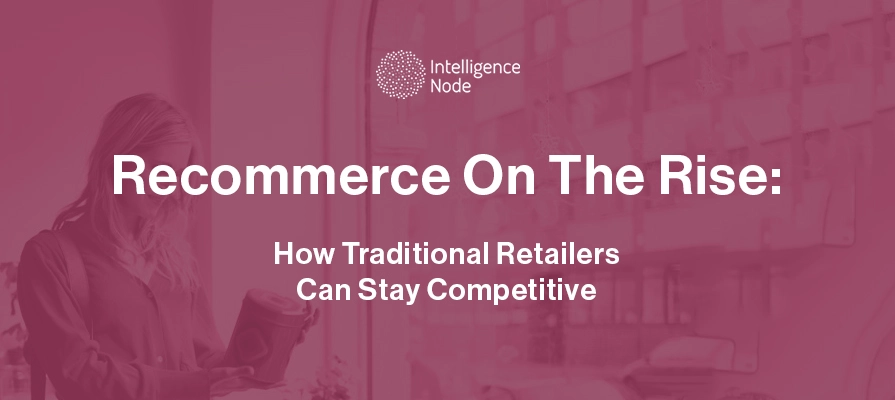This article was first published on Forbes on Oct 7, 2020, and is authored by Intelligence Node CEO Sanjeev Sularia in his capacity as a member of the Forbes Tech Council.
Driven in large part by millennials and Generation Z, the resale, or “recommerce,” market is booming. Currently worth approximately $24 billion, it is projected to reach $51 billion by 2023.
As millennial and Generation Z shoppers gain more buying power, consumers are becoming more passionate than ever before about sustainable commerce. In fact, 73% of millennial consumers said they prefer to purchase from sustainable brands. As fashion is the second most polluting industry in the world, a shift away from fast fashion is no surprise.
And as the Covid-19 pandemic continues, it’s likely that recommerce will gain even more market share. In the midst of the pandemic, households are more budget-conscious than ever (yet still interested in aspirational brands) and are more likely to shop via digital channels to comply with social distancing guidelines. The Walmart and ThredUP partnership, launched in May, validates this mindset and strategy.
From eBay To The RealReal: How Resale Shopping Has Evolved
The sale and purchase of secondhand goods has been around since eBay consolidated the practice and moved it online in 1995. In the years since eBay, “secondhand shopping” lost its stigma and became blurred with traditional eCommerce shopping. What was once referred to as “thrifting” has now become unmistakably mainstream.
A major influence contributing to this shift is the fact that resale commerce is no longer associated with low-value or undesirable products. This change has been driven largely by luxury consignment shops that sell slightly used, high-end designer clothing, such as The RealReal and The Outnet. In fact, earlier this year, The RealReal opened its flagship store in San Francisco — a sign that recommerce of all kinds is here to stay.
How Traditional Retail Stores Can Stay Competitive
Shopping in the recommerce market is attractive to consumers for several reasons: It’s more sustainable, a dollar can go farther and the products often feel one-of-a-kind.
This presents a very real threat to traditional retail stores. However, as resale continues to grow, there are several strategies traditional retailers can use to maintain their edge:
1. Promote sustainability efforts.
The foundation of recommerce is the concept of the circular economy — an economic system that is aimed at eliminating waste and driving the continual use of resources. In fashion, this means ensuring clothing is durable, rather than disposable.
While traditional retail brands aren’t able to contribute to the circular economy directly, they can ensure (and promote) the durability and sustainability of the goods they sell. This appeals to the socially aware and responsible consumers who might not be looking for used clothing but still have a desire to be environmentally conscious while they shop.
Recent data shows that nearly 40 million U.S. adults prefer companies that support the community and that millennials are more likely to support brands that consider environmental issues, such as the use of green packaging or a commitment to programs that reduce energy use.
2. Be smart with your pricing.
In the midst of steep discounts offered by recommerce options, traditional retailers need to be strategic about product pricing if they wish to win their share of the consumer dollar.
Traditional retailers should be benchmarking similar products that are being offered elsewhere (secondhand or not), monitoring how the market is responding and increasing or decreasing their prices based on that insight. Smart pricing solutions will be the best bet for sellers to quickly respond to consumer demand and adjust prices to drive sales, move inventory and gain a real advantage over competitors.
3. Focus on category management.
Traditional retailers must constantly be innovating to attract and retain customers, something that is especially important in the wake of Covid-19.
Category management — or the practice of organizing retail categories as independent business units — can help stores identify key value categories, optimize certain products’ “shop-ability,” use resources more efficiently and increase category sales volume. This translates to a more enjoyable shopping experience for the customer through sales and promotions, competitive pricing and an improved product mix.
Growth Of Recommerce Does Not Signify The Decline Of Traditional Retail
While the recommerce market is heating up (and for good reason), this doesn’t necessarily have to mean the decline of traditional retail. While many consumers have come around to the idea of shopping for products secondhand, the truth is that there is still a large portion of consumers who prefer to purchase unused items. And recommerce can actually complement traditional retail by helping brands engage with consumers in new ways or encouraging them to experiment with different fashion trends.
The key to tapping into this market is making the shopping experience, both digital and in-store, as gratifying as it is when shopping for consignment goods. This can be achieved by offering products that are certified sustainable, priced competitively with similar options on the market and as diverse as the items you might see available in a secondhand shop.
About Intelligence Node :
Intelligence Node is an eCommerce analytics platform that benchmark against your competitor products and prices in real-time and stay ahead of the game with AI-driven intelligence. Learn More.




